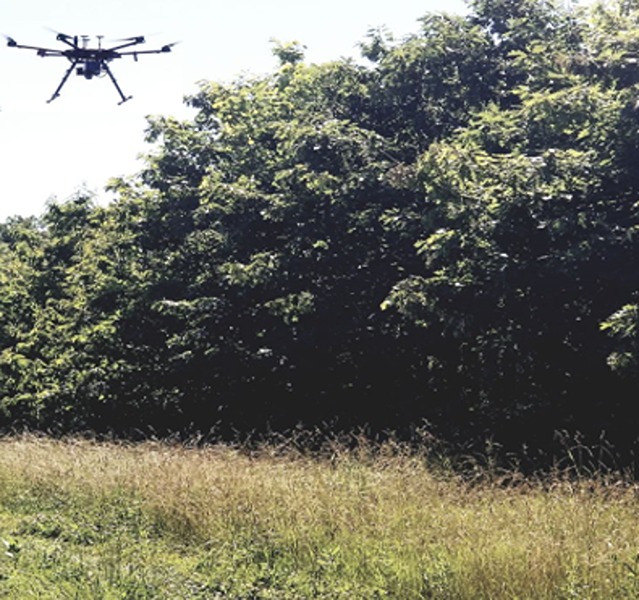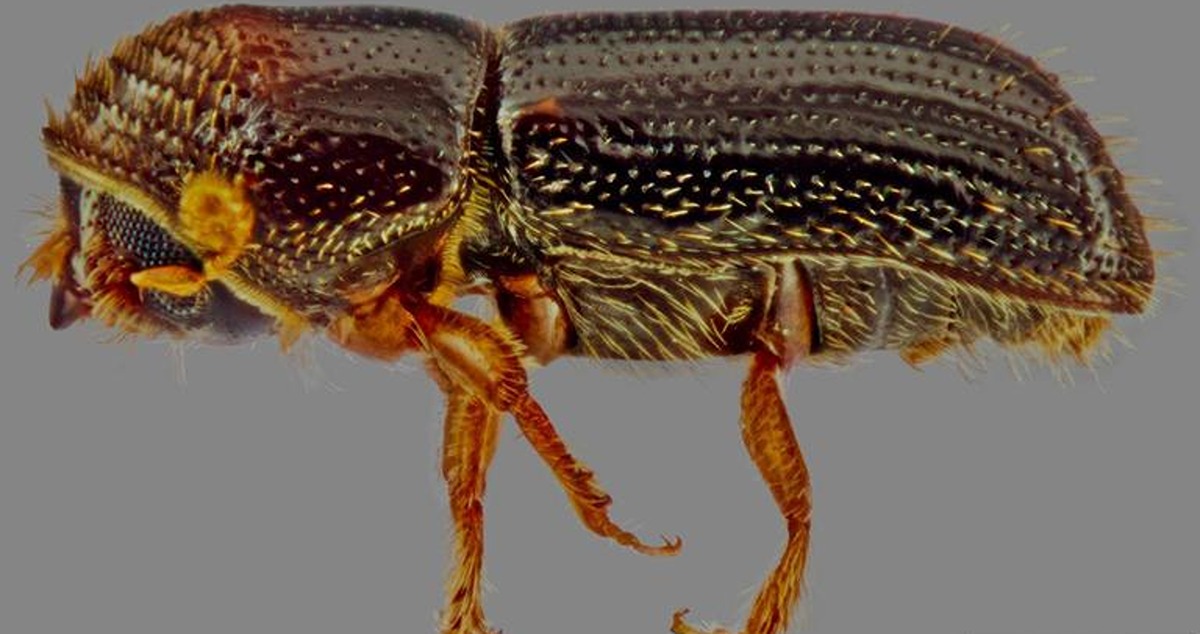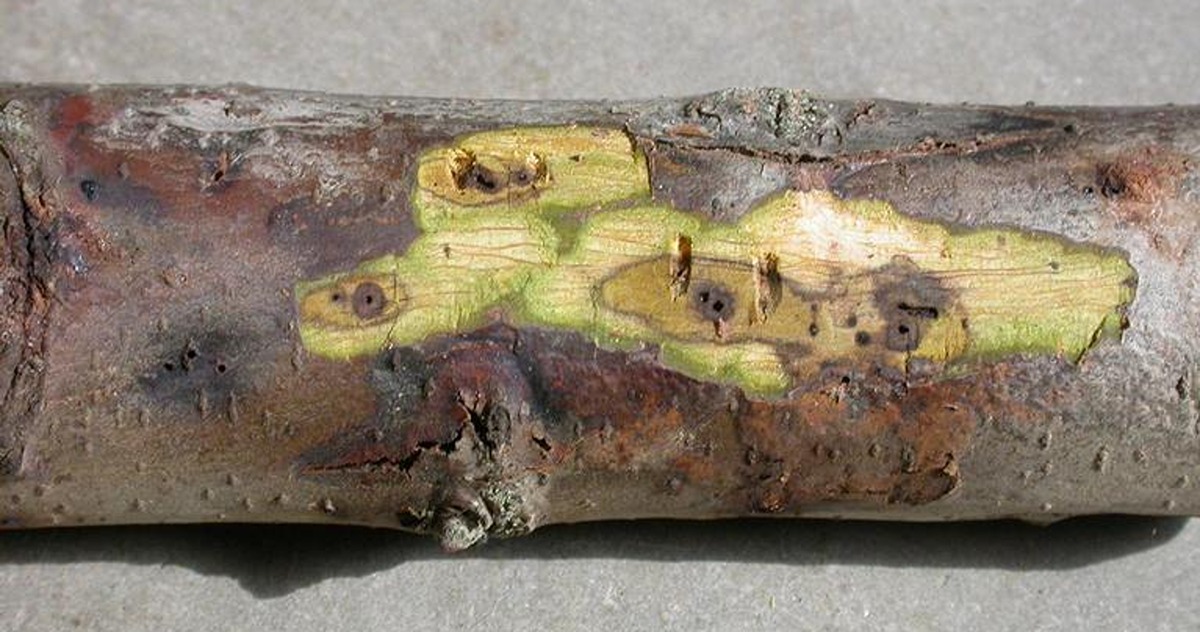The black walnut tree (Juglans nigra), prized for its rich, dark color in hardwood furniture and floors, is native to Indiana and the eastern United States. It’s no surprise that settlers who moved westward across the country put walnuts in their pockets to plant the beloved trees across the new frontier to remind them of home. What they didn’t think of is how the insects that affect western Juglans species might make the jump to their eastern black walnut.
The walnut twig beetle (Pityophthorus juglandis) is native to the southwestern US and bores into walnut trees to feed on its inner bark. On its body, the beetle carries a pathogenic fungus called Geosmithia morbida that infects the tree. The fungus grows under the tree’s bark and continues to steal nutrients from the tree, causing an injury called a canker about the size of nickel. This shouldn’t be a big problem for a big tree, except for the fact that tens of thousands of walnut twig beetles can feed on a single tree, resulting in many wounds on that tree, giving the accrued, fatal disease the name “Thousand Cankers Disease” (TCD).
Two professors in Purdue’s Institute for Digital Forestry, Matt Ginzel, who studies forest health and chemical ecology, and John Couture, who studies plant and insect chemical ecology and vegetation spectroscopy, came together to study how the environment affects the occurrence of TCD.
In 2012, there was a drought in Tennessee that taught them how important the environment is to the onset of the disease. Ginzel shared that “because of TCD, some trees looked like they were on death’s door. 90% defoliation—leaves start to droop and yellow, and scaffold branches die off. Before long, it just can't muster any energy any longer, and it dies. Well, after some regular precipitation, in the subsequent years, some trees recovered. They were able to shake this infection. Geosmithia morbida can only outcompete other common tree fungi at low wood-moisture content. It appears to be adapted for a dry southwestern environment.”
Everything from the weather to the level of stress to what soil microbes are present can influence whether or  not a tree survives this pathogen. Ginzel and Couture realized that measuring these factors could them give insights which would help breeders select for traits for black walnut trees that are less susceptible to Geosmithia and more tolerant to drought.
not a tree survives this pathogen. Ginzel and Couture realized that measuring these factors could them give insights which would help breeders select for traits for black walnut trees that are less susceptible to Geosmithia and more tolerant to drought.
Couture’s experience with vegetation spectroscopy came in handy. Spectroscopy is a technique of looking at how light interacts with a substance. Scientists can shine a light on something of interest, known as the substrate, and take measurements of the light that is absorbed, passed through and reflected back off the substrate. For vegetation, this approach provides information on the chemical and physiological make-up of the plant.
“Remote-sensing spectroscopy has more recently been used to understand vegetation health in a breeding context,” Couture explained. “It gives you a snapshot of how a plant is feeling at a certain time. We can relate the different chemical and physiological responses that it’s exhibiting to determine if that plant is experiencing pathogen stress, water stress or something else.”
Couture and Ginzel’s preliminary work not only indicates that they can tell the difference between water stress and pathogen stress on trees at the spectral level, but they are also able to detect the influence of one stressor on the presence of the other. This will help identify key characteristics in trees that can withstand drought stress and shake off a pathogen like Geosmithia morbida, information that could have major impacts on black walnut breeding.
Ginzel said, “This is a nice system to be working in because it could all be applied to other pathosystems of trees.”
True to their word, Ginzel and Couture are also working on another invasive insect system that affects eastern black walnut trees. The spotted lanternfly (Lycorma delicatula) was introduced from Asia to the east coast in 2010 and has made quick work moving across the US. It follows railways, shipping channels and highways, favoring disturbed areas and laying its eggs on anything. It prefers habitats with tree of heaven (Ailanthus altissima) and black walnut, its favorite foods.
coast in 2010 and has made quick work moving across the US. It follows railways, shipping channels and highways, favoring disturbed areas and laying its eggs on anything. It prefers habitats with tree of heaven (Ailanthus altissima) and black walnut, its favorite foods.
With their partners at Penn State and Temple University, Ginzel and Couture are moving from detection to prediction. They’re using satellite imagery and remote-sensing spectroscopy to overlay the factors of temperature, habitat quality, host tree heath and the pathways of disturbed areas available to the spotted lanternfly to predict its movements.
“Can we get a better idea of where something’s going to be before it gets there?” Couture asks. “We have limited management resources. Having predictive tools will allow us to suggest areas that should be most targeted for management.”
The Ginzel and Couture labs are working to create online public survey tools that would allow anyone to enter in basic information about their land and get an instant reading of how likely the invasive insects are to establish on their property. They know that it is important to bring Indiana landowners into their research, not just to help them, but also because observant landowners are often the first to notice odd, new insects in their yards.
Ginzel asks landowners to, “Be vigilant. Look at your trees. If you believe you have spotted an invasive species, report it and, if possible, get pictures to assist in expert identification. You can report invasive insect sightings to the DNR by calling 1-866-NO-EXOTIC.”







